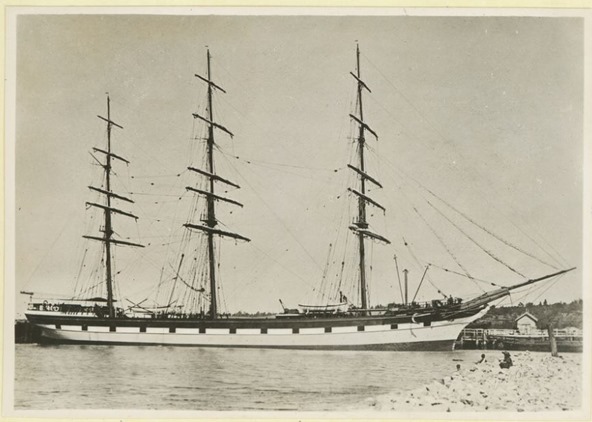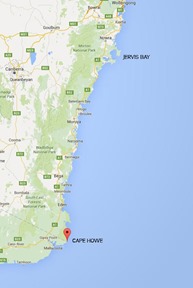| You don't usually find such a graphic account of the circumstances surrounding this types of incident, but this account brings you right onto the decks of the Loch Katrine. It takes you to a place where frightened men battled the elements trying to stay alive as they tried to avoid flying debris as the ship was being torn apart around them, you can imagine the sounds of the waves engulfing the ship, the grinding of timber against timber, the groans of the rigging and the steel hull as the Loch Katrine strained against the sea and wind.
Ill start with an understated comment from the very experienced Captain Martin, Master of the Loch Katrine, he had spent most of his life at sea serving on the "Loch" line of clippers.
" It was the most trying experience I had passed through"
after reading the story I can see why.
The Loch Katrine was overdue in Sydney and a certain uneasiness was felt about the fate of the vessel.
April 27th Wednesday - 2.30am.
The barque Loch Katrine of the Loch line of clippers was on a trip between Melbourne and Sydney carrying a cargo of general goods from Gladscow with a crew of 22.
When off the eastern entrance to Bass Straight she ran into a violent hurricane four days after leaving Melbourne, driving her down to leeward. Almost immediately down came the main top mast short of the cap, bringing with it the mizzen topgallant mast. The wreckage fell with a terrific crash, and some of it, hanging from aloft swung to and fro for half an hour, threatening to pierce the hull and send the ship to the bottom. Eventually the crew managed to cut it away, but then the heavy rolling of the vessel caused the main mast to come down. It snapped 3ft from the deck, the wreckage smashing the starboard boat on the chocks to atoms before going over the side. With only the foremast complete the barque was left a floating hulk, and she rolled to such an extent that the crew stated they had never experienced anything like it..
“She fairly rolled with the rails under and the men were working waist deep in water in their efforts to keep the ship under something like control’'.
The storm had left behind a heavy sea, and the violent rolling and pitching had it's effect. The crane of the lower top sail yard carried away, the yard coming down on the foreyard taking with it the truss. This bought the upper top sail yard down also. 8 a.m Wednesday.
Three topmast back stays went off the starboard side, and the topmast crashed overboard, leaving only the foremast and foreyard standing. The vessel was tumbling so badly that the men could not keep their feet. 10a.m.Wednesday.
The mizzen topmast went with a crash, half the mast along with the gaff, remaining aloft, swinging about to the peril of all. The spanker boom also came down on deck, smashing the pooprail and starboard compass. 12 p.m. 28th Thursday.
The foremast broke off 4ft from the deck. The wreckage went through the main hatch and also smashed the pumps. The crew had a lively time dodging the falling wreckage and they subsequently kept busy clearing it off the deck. It was dark before the decks were cleared, an examination showed the jib boom had broken off short of the cap.
Sleep was impossible because the rolling ship kept tossing them out of their bunks.
 April 29th. Friday
The barque passed through a westerly gale, and made very bad weather, the decks being kept in a chronic state of flood. Efforts were made by the crew to set up a jury rig with little success. 3 p.m.
The crew cut a tow rope up and had fourstay sails set. They then took the spanker boom onto the main deck to make it ready to send aloft. May 1st Sunday.
The boom was rigged. May 2nd - Monday.
They set the spanker boom over the end and lashed it to the foremast so as to set a royal fore top mast stay sail.
The lifeboat was put over the side and readied for assistance, the Loch Katrine was perfectly helpless in the sea way, and was hove to, the idea being to try and hold the vessel in the vicinity of the event incase of assistance being sent. A change of wind drove her away north. May 3rd - Tuesday.
In a moderating sea the Captain decided to dispatch the lifeboat, with six men. Volunteers were asked for and every man put his hands up, 6 men were chosen, 4 for hauling and to spelling, they were now 150 miles south-east of Cape Howe, they estimated it would take four days to see Gabo Island, they were provisioned for 10 days. The mate was instructed to steer for Twofold Bay, they were furnished with the necessary charts. The Captain felt sure they would soon reach land and report their condition.
May 5th. - Friday.
She was going before a southerly blow. Having jury-rigged the vessel in order to navigate they made fair progress, and logged 72 miles on the first day. May 7th - Sunday
She had been swept into the vicinity of Montague Island by noon.. 6 p.m
The same day they sighted Point Perpendicular light. May 8th - Monday.
By the next morning they were abreast of Jervis Bay still heading north 16 miles off land. The wind fell away and under the influence of a strong southerly current swept them 5 to 6 miles southward again. The wind freshened from the south again and the captain headed in for the land in a north-west direction. 3p.m
They were once again abreast of Jervis Bay. The Jervis bay lighthouse was again in sight. The barque had signal "N.C". flying, but there was no answer. Rockets were fired Sunday night, but without result, but the captain was confident they had been seen.

N.C International Distress Signal Flag
November / Charlie
The Loch Katrine crew had no way of knowing her plight had been reported, and arrangement had been made with the agents to dispatch the 125ft long tugboat Heroic on the 7th to find the stricken vessel, not knowing where she was located this could have taken many weeks, but fortunately the tug came upon the vessel the next day. The watchful crew noticed a tug steaming towards their stricken vessel. On arrival at the scene the Heroic dispatched meat, potatoes, vegetables and tobacco to the distressed crew, and all hands were thankful for their deliverance.
Her arrival into Port Jackson as reported in the Advertiser May 11th.
"Rolling lazily at the end of a long length of towline from Fendwick's tug Heroic, the dismasted barque Loch Katrine hove in sight off Sydney Heads at daylight. The tug picked her up east of Jervis Bay, and bought her along at easy pace. He appearance at the south reef was the signal for much satisfaction, and loud cheers were set up from the crews of passing vessel as the crippled barque swung into the eastern channel and up the harbour. The old Glasgow clipper was in a sorry plight. Never before, perhaps, has a vessel made port in such a dismasted condition. But for a short boom rigged up on the stump of the foremast and mizzen mast there has been a clean sweep of everything and viewed from the poop deck the vessel presents a battered and weather beaten appearance.
 -
Distress call unanswered by Jervis Bay Lighthouse? The Captain was at a loss to understand why his distress signals were ignored by the Jervis Bay Lighthouse. He said that as soon as he sighted the lighthouse on Sunday Evening he fired several rockets, and when abreast of Jervis Bay, only 10 miles off land, on Monday afternoon, he hoisted a flag code signal that he was in distress, and wanted immediate assistance. No notice was taken of either signal, although from the Loch Katrine the flagstaff of the signal station could be distinctly seen with the naked eye. The alarm was raised after the men who had left the boat on Tuesday the 3rd headed for Twofold bay came within sight of Gabo Island. They were then seen and picked up by the Swedish steamer “Tasmanic” on Friday the 6th. They were well looked after, given seperate cabins and they had their first sleep in nine days.
|  The iron ship 'Loch Katrine', 1252 tons, in an unidentified port. Aprox 1880.
The iron ship 'Loch Katrine', 1252 tons, in an unidentified port. Aprox 1880.








No comments :
Post a Comment